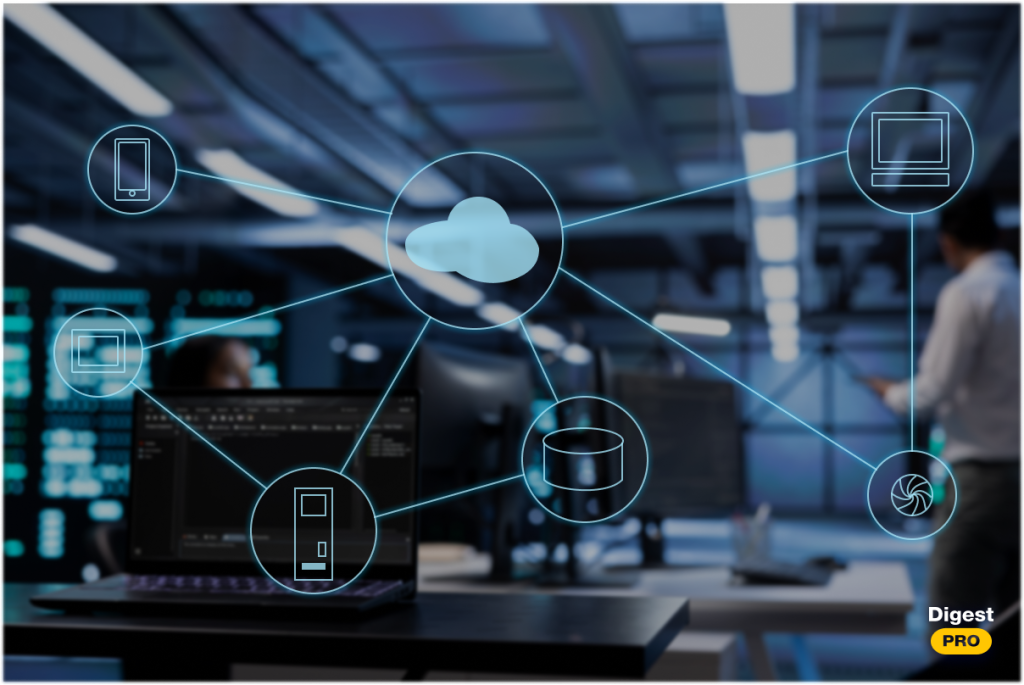
25 years ago, Salesforce emerged as a pioneering SaaS vendor that transformed the design and architecture of software. In turn, Amazon Web Services and Microsoft Azure established future trends in cloud computing for the coming decades, reinforcing the role of cloud technologies in modern business models. In 2025, such solutions will continue their long-term evolution while disrupting industries. Let’s explore how cloud computing trends remain a dominant force poised to further shape the future of organizations and major industries.
Why Trends in Cloud Computing Are Crucial for Modern Organizations
Beneath the incomparable success of cloud computing lies a simple yet powerful principle: to provide resilience, flexibility, and cost-effectiveness to business models. Undoubtedly, cloud solutions have become highly valuable in both non-commercial and public organizations, particularly in government and defense sectors. In this regard, trends in cloud computing are shaped by the following factors:
- Advanced Process Automation and Workflow Optimization. Cloud computing serves as a critical foundation for minimizing downtime by automating complex workflows across manufacturing and service industries. This technology enables businesses to integrate IoT, AI, and big data analytics to enhance processes.
- Cost Optimization and Financial Efficiency. Replacing traditional on-premises hardware, cloud solutions offer pay-as-you-go pricing models and affordable software access. These services equip organizations with up-to-date tools that receive regular updates.
- Remote and Hybrid Work Enablement. A key driver of current trends in cloud computing is the hybrid approach to workflow execution. Cloud-hosted automation tools enhance productivity through seamless synchronization and broad accessibility across devices, particularly mobile phones.
- Continuous Innovation and Competitive Edge. Companies that have already adopted cloud solutions tend to innovate more rapidly, gaining market leadership while maintaining resilience in today’s disruptive environments.
- Scalability and Agility. Modern digital tools and business solutions are increasingly built on cloud-native platforms, reducing the need for traditional infrastructure installation and maintenance, and enabling faster adaptation to industry shifts.
How Cloud Computing Trends Are Defining the Future of Business and Technology
Current trends in cloud computing are undergoing dynamic developments due to their widespread application across major sectors beyond business. Cloud computing has become a universal technology in everyday life, science, healthcare, and the public sector, where such solutions enhance convenience while addressing common challenges ranging from outdated bureaucracy to high-cost barriers to services. In this context, cloud computing trends in 2025 are shaping the future in the following ways:
- AI will become an integral component of cloud systems, enabling next-generation automation of services and tools, such as self-healing operations.
- Industry-specific ready-to-use cloud configurations will provide unprecedented solutions to common challenges.
- A unified shared data layer will eliminate the need to duplicate data across devices, allowing seamless transmission of data and applications with minimal latency to deliver instant responses regardless of data volume.
- Simplified coding and application development through cloud platforms will reduce the need for extensive custom engineering.
- Zero-trust security will become the default data protection standard, with cloud technologies playing a critical role in advancing this framework.
Overview of Critical Cloud Computing Trends Impacting 2025 and the Evolving Tech Landscape
We have outlined the driving forces and needs that contribute to the ongoing development of cloud solutions, where this technology serves as a critical enabler of broader digitalization processes. Cost-effectiveness and accessibility are also key reasons why cloud computing will dominate industries, becoming a universal standard for the coming decades. Based on these findings, it is reasonable to elaborate on them by highlighting the most essential cloud computing trends.
Revolutionary Intelligence: AI and Machine Learning
Available cloud-based solutions will advance through deep integration of generative AI and ML pipelines into their platforms. Model as a Service is a strong example of how modern cloud computing trends enable the rapid deployment of custom AI solutions within organizations. Such developments will also reinforce the demand for personalized cloud experiences, driven by self-automation and the use of synthetic data to train models. This will enable advanced data analytics and hyperpersonalization across most features and services.
Cloud Security and Compliance
As mentioned above, zero-trust frameworks are becoming an integral component of cloud security, while identity-first approaches will also protect API calls and data flow. Moreover, one of the critical cloud computing trends in 2025 reflects the ambitious goal of achieving real-time automated policy engines to enforce regulations. Therefore, these key trends will ensure minimal breach risk, and, along with automation and proactive monitoring, cloud solutions will continue their confident progression.
Multi-Cloud and Hybrid Cloud Strategies
Unified control planes span public clouds and on-premises systems, representing an important advancement in the context of cloud computing trends. Users will receive stable and affordable services, which also allows enterprises to avoid being locked into a single vendor. Such flexibility is a critical strategic asset that enables organizations to innovate and maintain data security, becoming an integral element of competitive advantage and resilience in highly uncertain and dynamic environments.
The New Frontier: Edge Computing
Major industries, especially manufacturing, will enjoy ultra-low latency while achieving excellent interoperability between computing systems and devices enabled by cloud technologies. Among critical cloud computing trends, edge solutions significantly enhance IoT and smart devices that boost safety, uptime, and efficiency. Moreover, these systems provide next-generation automation, which is critical in large manufacturing units, while ensuring uninterrupted operations since edge nodes can continue performing basic tasks autonomously.
Serverless and Cloud-Native Development
Functions-as-a-Service, along with Backend-as-a-Service, comprises other emerging cloud computing trends that simplify updates and deployment processes. Moreover, these are cost-effective and scalable platforms that reduce expenses by offering flexible billing models. Enterprises gain a powerful cloud-based technology that enables their business to adapt to market shifts by rescaling with strong cost control.
Cloud Cost Management and Optimization
Enhanced cost management complements the list of trends in cloud computing. Powered by AI, professionals gain highly useful features that allow them to manage costs in real time while identifying idle resources. Cloud solutions offer proactive budget planning, which is a crucial success factor for organizations seeking to optimize spending and resource allocation.
Sustainability and Green Cloud Initiatives
Commitment to green energy and decarbonization remains a prime priority within the modern entrepreneurial paradigm. Most clean energy companies integrate cloud-based technologies to leverage their capabilities. It is reasonable to assert that green cloud initiatives will play a crucial role in supporting the circular economy, while greentech startups will embed cloud technologies by default in their business models to gain investor support.
Low-Code and No-Code Cloud Solutions
Visual drag-and-drop builders remain one of the most frequently cited trends in cloud computing, gaining practical relevance due to their established maturity. Pre-built AI and ML components empower citizen developers, who are non-IT employees to build or customize applications, thereby reducing hiring costs. This solution is particularly relevant for SMEs and startups, where rapid prototyping combined with these features drives digital innovation across business, healthcare, and government sectors.
Resilient by Design: Disaster Recovery and Business Continuity
Cloud computing trends identify recovery services as an essential technology in the big data era. Additionally, this critical feature will gain increased relevance amid geopolitical uncertainties and hazards by securing vital information for enterprises. Cloud technologies also make the recovery process accessible without long wait times for data retrieval, which is a highly valuable utility in cases of infrastructure or organizational migration.
Next-Gen Cloud Tech: Blockchain and Quantum Computing
The final and most influential cloud computing trend in 2025 is the advancement of blockchain and quantum computing. While Blockchain-as-a-Service revitalizes commercial interest in the technology by making it more applicable for companies, quantum computing has the potential to create a paradigm shift in the current technological landscape. Quantum technologies can partially substitute the need for large AI data centers by compensating for computational power, and their minimal energy consumption makes them a cost-effective solution for experimental applications such as large-scale optimization and drug discovery, where the power of supercomputers will accelerate these processes.
Final Thoughts on the Future Trends in Cloud Computing
The upcoming trends in cloud computing will be defined by the directions summarized above. The primary goal of cloud computing is to create a globally connected system that fundamentally reduces manual input, replacing it with sensors and devices. While this vision may seem futuristic, we believe that quantum computing will revolutionize industries, particularly by driving next-generation agentic AI solutions. Vertical cloud platforms tailored to specific sectors are expected to emerge in the next few years, thereby accelerating innovation and digital transformation in other spheres.
Frequently Asked Questions (FAQ)
Q: What should entrepreneurs know about cloud computing beyond its benefits?
A: Entrepreneurs and professionals should carefully consider pricing, vendor portability, security, integration with legacy systems, and sustainability before committing to a cloud provider.
Q: What cloud computing trends offer significant value to startups and SMEs?
A: We recommend Security-as-a-Service, Disaster Recovery-as-a-Service, Cost Governance Platforms, and Operations-as-a-Service as additional trends that business founders should explore to enhance productivity and strengthen business model resilience.
Q: How important is the sustainability trend within cloud computing developments in 2025?
A: Sustainability is becoming a critical driver of cloud computing trends, underscored by regulatory pressures, corporate ESG goals, and improvements in cost efficiency.




